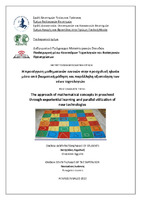| dc.contributor.advisor | Παναγιωτακοπούλου, Ιωάννα - Σταματίνα | |
| dc.contributor.advisor | Panagakos, Ioannis | |
| dc.contributor.author | Χατζηδάκη, Αγγελική | |
| dc.date.accessioned | 2022-07-21T06:04:13Z | |
| dc.date.available | 2022-07-21T06:04:13Z | |
| dc.date.issued | 2022-07-15 | |
| dc.identifier.uri | https://polynoe.lib.uniwa.gr/xmlui/handle/11400/2581 | |
| dc.identifier.uri | http://dx.doi.org/10.26265/polynoe-2421 | |
| dc.description.abstract | Εισαγωγή: Τα παιδιά προσχολικής ηλικίας έρχονται σε επαφή με αρκετές μαθηματικές
έννοιες μέσα από το παιχνίδι και την αλληλεπίδραση με το περιβάλλον τους. Η προσχολική
αγωγή οφείλει να συστηματοποιήσει την μαθηματική εκπαίδευση εφαρμόζοντας κατάλληλες
πρακτικές για μικρά παιδιά (Ζαχάρος, 2006). Η παρούσα εργασία αποτελεί μία
βιβλιογραφική έρευνα γύρω από τη διδακτική των μαθηματικών σε παιδιά προσχολικής
ηλικίας, την αξιοποίηση των ΤΠΕ στην μαθηματική εκπαίδευση καθώς και την διερεύνηση
της αποτελεσματικότητας προγράμματος μαθηματικών δεξιοτήτων που συνδυάζει το
βιωματικό παιχνίδι με απτά υλικά και ψηφιακά μέσα.
Σκοπός: Σκοπός της εργασίας είναι η διερεύνηση της αποτελεσματικότητας συγκεκριμένου
παρεμβατικού προγράμματος που αφορά την εξοικείωση παιδιών προσχολικής ηλικίας σε
μαθηματικές έννοιες των βασικών επιπέδων γεωμετρικών σχημάτων, μέσω της βιωματικής
μάθησης και του παιχνιδιού.
Μέθοδος: Η μεθοδολογία που χρησιμοποιείται για αυτόν τον σκοπό είναι η ποιοτική.
Εφαρμόζεται η τεχνική της έρευνας – δράσης ακολουθώντας σε αυτήν τις αρχές της
βιωματικής μάθησης μέσα από το παιχνίδι και την χρήση μέσων τεχνολογίας. Τα
μεθοδολογικά εργαλεία τα οποία χρησιμοποιήθηκαν είναι η παρατήρηση, η τήρηση
ημερολογίου, η φωτογράφηση των δράσεων των παιδιών, η συνέντευξη σε μορφή ανοιχτής
συζήτησης και η τήρηση φακέλου κάθε μαθητή.
Αποτελέσματα: Η ανάλυση των δεδομένων της έρευνας, έπειτα από την εφαρμογή της
διδακτικής παρέμβασης, ανέδειξε τις ικανότητες των παιδιών ως προς την αναγνώριση,
ονομασία και ομαδοποίηση των τεσσάρων βασικών σχημάτων. Όσο αφορά τον σχεδιασμό
και την κατασκευή των σχημάτων αυτών τα παιδιά έδειξαν ευκολία στην κατασκευή και
σχεδίαση του κύκλου και μεγαλύτερη δυσκολία στα υπόλοιπα σχήματα όπου και
χρειάζονταν υποστήριξη από τα άλλα παιδιά της ομάδας ή την παιδαγωγό.
Συμπεράσματα: Ο σχεδιασμός μαθησιακών δραστηριοτήτων που συνδυάζουν την
αλληλεπίδραση των παιδιών προσχολικής ηλικίας με απτά και ψηφιακά υλικά μεσώ της
βιωματικής μάθησης και του παιχνιδιού, συντελούν στην εξοικείωση των παιδιών με
μαθηματικές έννοιες των βασικών επίπεδων γεωμετρικών σχημάτων.
Η δυσκολία των παιδιών εντοπίστηκε στην κατηγοριοποίηση των γεωμετρικών σχημάτων
και ιδιαίτερα του τριγώνου και του ορθογώνιου παραλληλόγραμμου όταν άλλαζε η
τοποθέτησή τους στο χώρο, το μέγεθός τους και ή μορφή τους. Επομένως η ενασχόληση
των παιδιών με δραστηριότητες που παρέχουν τα σχήματα σε διαφορετικά μεγέθη, και
μορφές είναι πολύ σημαντική για τη βελτίωση της εννοιολογικής τους κατανόησης. | el |
| dc.format.extent | 113 | el |
| dc.language.iso | el | el |
| dc.publisher | Πανεπιστήμιο Δυτικής Αττικής | el |
| dc.publisher | Ανώτατη Σχολή Παιδαγωγικής και Τεχνολογικής Εκπαίδευσης (Α.Σ.ΠΑΙ.Τ.Ε.) | el |
| dc.rights | Αναφορά Δημιουργού - Μη Εμπορική Χρήση - Παρόμοια Διανομή 4.0 Διεθνές | * |
| dc.rights | Attribution-NonCommercial-NoDerivatives 4.0 Διεθνές | * |
| dc.rights.uri | http://creativecommons.org/licenses/by-nc-nd/4.0/ | * |
| dc.subject | Προσχολική ηλικία | el |
| dc.subject | Μαθηματική εκπαίδευση | el |
| dc.subject | Γεωμετρικά επίπεδα σχήματα | el |
| dc.subject | Διδακτική των μαθηματικών | el |
| dc.subject | Τεχνολογίες της πληροφορίας και των επικοινωνιών | el |
| dc.title | Η προσέγγιση μαθηματικών εννοιών στην προσχολική ηλικία μέσα από βιωματική μάθηση και παράλληλη αξιοποίηση των νέων τεχνολογιών | el |
| dc.title.alternative | The approach of mathematical concepts in preschool through experiential learning and parallel utilization of new technologies | el |
| dc.type | Μεταπτυχιακή διπλωματική εργασία | el |
| dc.contributor.committee | Παναγάκος, Ιωάννης | |
| dc.contributor.committee | Παναγιωτακοπούλου, Ιωάννα - Σταματίνα | |
| dc.contributor.faculty | Σχολή Επιστημών Υγείας & Πρόνοιας | el |
| dc.contributor.department | Τμήμα Βιοϊατρικών Επιστημών | el |
| dc.contributor.master | Παιδαγωγική μέσω Καινοτόμων Τεχνολογιών και Βιοϊατρικών Προσεγγίσεων | el |
| dc.description.abstracttranslated | Introduction: Most aspects of human activity involve forms of formal or informal
mathematical thought. Children come into contact with several pre-school mathematical
concepts through play and interaction with their environment. In this simple way they are
able to construct mathematical knowledge. Preschool education must undertake the
construction of this knowledge in a systematic mathematical education by applying
appropriate practices for young children (Zacharos, 2006). The present work was carried out
by the need for bibliographic research on the teaching of mathematics to preschool children,
the mathematical concepts they can approach, the use of information and communication
technology in mathematics education and to investigate the effectiveness of a mathematics
program skills that combine experiential play with tangible materials and digital media.
Purpose: The purpose of the work is to investigate the effectiveness of a specific
intervention program that concerns the familiarization of preschool children in mathematical
concepts of the basic levels of geometric shapes, through experiential learning and play.
Method: The methodology used is qualitative. The action research technique is applied,
following the principles of experiential learning through play and the use of technology. The
methodological tools used are observation, keeping a diary, photographing the children's
actions, interviewing in the form of an open discussion and keeping a file of each student.
Results: The analysis of the research data, after the implementation of the teaching
intervention, highlighted the abilities of the children in terms of recognition, naming and
grouping of the four basic shapes. Regarding the design and construction of these shapes,
the children showed ease in the construction and design of the circle and greater difficulty
in the other shapes where they needed support from the other children in the group or the
teacher.
Conclusions: Designing learning activities that combine preschool children's interaction
with tangible and digital materials through experiential learning and play contribute to
children's familiarity with mathematical concepts of basic flat geometric shapes.
The children's difficulty was identified in the categorization of geometric shapes and
especially the triangle and the rectangular parallelogram when their location in space, their
size and/or shape changed. Therefore, engaging children in activities that provide shapes in
different sizes, and shapes is very important for improving their conceptual understanding. | el |


